Greetings, fellow SkyWatchers! With the Moon gone from the early evening skies and the weather beginning to warm for northern climes, isn’t it about time you at least took a pair of binoculars out and scanned the skies with me? Some of mankind’s greatest astronomers were born over the next three days, included J.L.E. Dreyer, Fritz Zwicky, William Pickering and Galileo Galilei! Although our weekend targets are simple and you’ve probably already seen them before – how long has it been since you’ve last looked? Or tried with alternative sized optics? Ah… Yes. You begin to see the light! Come on. Dust those old binoculars off and head out into the back yard. I’ll be waiting…
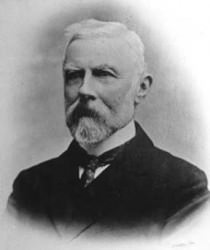 Friday, February 13, 2009 – A bad luck day? Not hardly. It was rather fortunate, because Johan Ludvig Emil Dreyer, was born on this date in 1852. At age 30, Danish astronomer Dreyer became director of the Armagh Observatory—not a grand honor, considering the observatory was so broke it couldn’t afford to replace its equipment. Like all good directors, Dreyer somehow managed to get a new 10″ refractor but no funds for an assistant to practice traditional astronomy. However, J.L.E. was dedicated and within 6 years had compiled all observations known to him into one unified work called the New General Catalogue of Nebulae and Clusters of Stars (NGC). Originally containing 7,840 objects, and supplemented in 1895 and 1908 with another 5,386 designations, the NGC remains the standard reference catalog. Although Dreyer’s personal observations included such nebulous descriptions as ‘‘a vault of stars,’’ modern astronomers continue to use his abbreviations as a kind of shorthand.
Friday, February 13, 2009 – A bad luck day? Not hardly. It was rather fortunate, because Johan Ludvig Emil Dreyer, was born on this date in 1852. At age 30, Danish astronomer Dreyer became director of the Armagh Observatory—not a grand honor, considering the observatory was so broke it couldn’t afford to replace its equipment. Like all good directors, Dreyer somehow managed to get a new 10″ refractor but no funds for an assistant to practice traditional astronomy. However, J.L.E. was dedicated and within 6 years had compiled all observations known to him into one unified work called the New General Catalogue of Nebulae and Clusters of Stars (NGC). Originally containing 7,840 objects, and supplemented in 1895 and 1908 with another 5,386 designations, the NGC remains the standard reference catalog. Although Dreyer’s personal observations included such nebulous descriptions as ‘‘a vault of stars,’’ modern astronomers continue to use his abbreviations as a kind of shorthand.
Honor Dreyer tonight by discovering one of his catalog objects suited for all optics – NGC2287.
Located about two finger-widths south of Alpha Canis Majoris (RA 06 46 00 Dec -20 46 00), only an open cluster this bright could stand up against brilliant Sirius. From a dark-sky location, your unaided eye can even spot this magnitude 4.5 “star vault” as a hazy patch. Aristotle saw it as early as 325 BC! Officially discovered by Hodierna, we know it best by the designation Messier Object 41. Even from 2,300 light-years away, the cluster’s brightest star, an orange giant, stands out clearly from the stellar nest. With large aperture, you’ll notice other K-type stars, all very similar to Sol. Although small scopes and binoculars won’t reveal too much color, you might pick up on the blue signature of young, hot stars. NGC 2287 could be anywhere from 190 to 240 million years old, but its stars shine as brightly now as they did in Aristotle’s day. . .and Dreyer’s!
Saturday, February 14, 2009 – Happy Valentine’s Day! On this date in 1747, astronomer James Bradley presented his evidence of Earth’s wobble, called nutation. The study took 19 years, but won Bradley the Copley Medal! In 1827, George Clark was born. The name might not ring a bell, but it was indeed a bell—melted down—that he used to create his first brass telescope. George’s family went on to produce the finest—and largest—telescopes of their time.
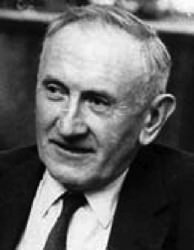 In 1898 crabby astronomer Fritz Zwicky came along, his name synonymous with the theory of supernovae. The Swiss-born Caltech professor was also a salty character, often intimidating his colleague Walter Baade and referring to others as ‘‘spherical bastards.’’ Although Zwicky was difficult to work with, he was also brilliant—predicting the phenomenon of gravitational lensing.
In 1898 crabby astronomer Fritz Zwicky came along, his name synonymous with the theory of supernovae. The Swiss-born Caltech professor was also a salty character, often intimidating his colleague Walter Baade and referring to others as ‘‘spherical bastards.’’ Although Zwicky was difficult to work with, he was also brilliant—predicting the phenomenon of gravitational lensing.
Tonight we’ll look at a supernova remnant as we venture to the Crab Nebula. Finding M1 is easy: it can be seen with as little as 7X magnification. Locate Zeta Tauri (about halfway between Orion’s ‘‘head’’ and the southernmost bright star in Auriga) and aim about 1 degree northwest (RA 05 34 31 Dec -22 00 52).
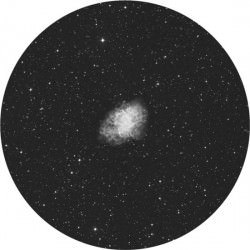 Viewing M1 with small optics helps to understand why Charles Messier decided to compile his famous catalog. Unaware of its earlier discovery, Messier located a fuzzy object near the ecliptic and assumed it was the return of Halley’s Comet. Considering his primitive telescope, we can’t fault his observation. But Chuck was a good astronomer. When he realized the object wasn’t in motion, he began compiling a log of things not to be confused with comets—the famous Messier objects. Enjoy looking at this spectacular deep-sky jewel, and we’ll study it in depth another time. Of course, Zwicky would have cursed me for saying that observing without science is an ‘‘empty brain exercise and therefore a waste of time.’’ But on the date of his birth, I took his advice. . . ‘‘Give me a topic and I’ll give you an idea!’’
Viewing M1 with small optics helps to understand why Charles Messier decided to compile his famous catalog. Unaware of its earlier discovery, Messier located a fuzzy object near the ecliptic and assumed it was the return of Halley’s Comet. Considering his primitive telescope, we can’t fault his observation. But Chuck was a good astronomer. When he realized the object wasn’t in motion, he began compiling a log of things not to be confused with comets—the famous Messier objects. Enjoy looking at this spectacular deep-sky jewel, and we’ll study it in depth another time. Of course, Zwicky would have cursed me for saying that observing without science is an ‘‘empty brain exercise and therefore a waste of time.’’ But on the date of his birth, I took his advice. . . ‘‘Give me a topic and I’ll give you an idea!’’
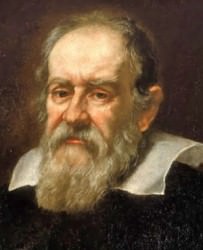 Sunday, February 15, 2009 – Are you ready to do a little IYA 2009 outreach? Then start now. This date’s astronomical births begin in 1564 with Galileo Galilei—pioneer of physics and astronomy—who didn’t invent the telescope but certainly perfected it. Arrested for heresy, Galileo entreated fellow scientists to discover the universal truths for themselves. His cry was ignored. To his friend, Johannes, he wrote: ‘‘I wish, my dear Kepler, that we could have a good laugh together at the extraordinary stupidity of the mob. What do you think of the foremost philosophers of this University? In spite of my oft-repeated efforts and invitations, they have refused, with the obstinacy of a glutted adder, to look at the planets or Moon or my telescope.’’
Sunday, February 15, 2009 – Are you ready to do a little IYA 2009 outreach? Then start now. This date’s astronomical births begin in 1564 with Galileo Galilei—pioneer of physics and astronomy—who didn’t invent the telescope but certainly perfected it. Arrested for heresy, Galileo entreated fellow scientists to discover the universal truths for themselves. His cry was ignored. To his friend, Johannes, he wrote: ‘‘I wish, my dear Kepler, that we could have a good laugh together at the extraordinary stupidity of the mob. What do you think of the foremost philosophers of this University? In spite of my oft-repeated efforts and invitations, they have refused, with the obstinacy of a glutted adder, to look at the planets or Moon or my telescope.’’
The birth of lunar and planetary observer William Pickering followed in 1858. During Pickering’s professional years at Harvard, he noted that the entire constellation of Orion is encased in faint nebulosity. Later verified by E.E. Barnard, this nebula is now known as Barnard’s Loop.
With a very dark sky and excellent transparency, you can trace the ‘‘Loop’’ with binoculars. The area is so large and it’s pointless to provide coordinates, but the brightest portion extends eastward between Alpha and Kappa. Because the Orion complex contains so many rapidly evolving stars, it stands to reason a supernova has occurred there. Barnard’s Loop is probably the ancient shell leftover from such a cataclysmic event. If taken as a whole, it would encompass 10 degrees of sky! More difficult for Northern Hemisphere viewers is IC 2118, a huge reflection nebula west of Rigel known as the ‘‘Witch Head.’’ Once photographed by Pickering, IC 2118 is more sensitive to film than to the eye,
but that doesn’t mean you can’t see it. Sky conditions are the decisive factor, so look closely around the eastern edge where the fueling stars are brightest. You just might surprise yourself!
Until next week? Dreams really do come true when you keep on reaching for the stars!
This week’s awesome photos are: J.L.E. Dreyer (historical image), NGC 2287: M41 (credit—Palomar Observatory, courtesy of Caltech), Fritz Zwicky (historical image), Messier Object 1 (credit—Palomar Observatory, courtesy of Caltech), Galileo (historical image) and Eastern edge of IC 2118 (credit—Palomar Observatory, courtesy of Caltech).

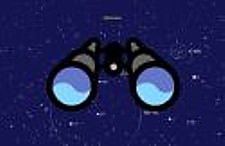
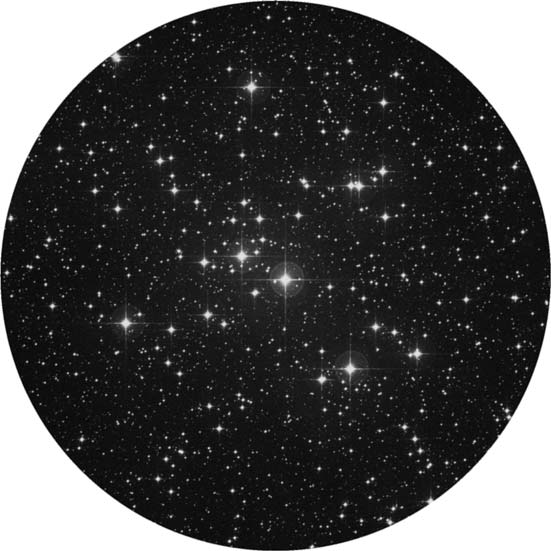
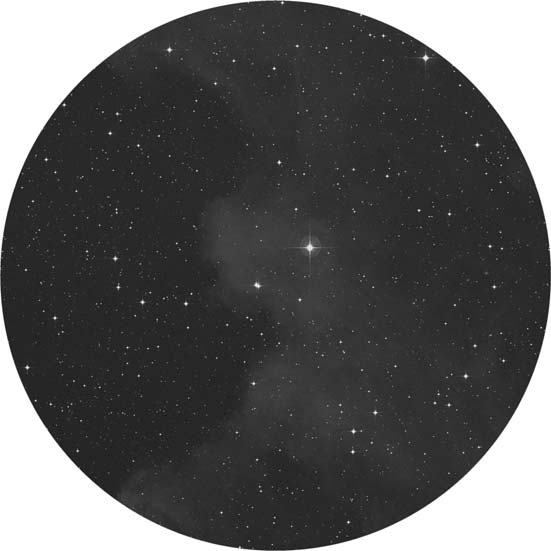
Wonderful article Tammy 🙂
And a pretty photo of Fritz Zwicky at last ! All the articles have seen until now, had a very ugly photo of him, while his discovery was very important for astronomy.
Thanks, Sofia! although I’ve referred to Dr. Zwicky as “crabby”, I have the utmost admiration for his work and, oddly enough, his attitude. When I research things, I often go off on a tangent and read a person’s whole biography (and views written about them by family and colleagues as well), even though I might only include a line or two about them.
Let’s just say that I can identify so very much with what Zwicky felt about how his work was treated and I can deeply understand his reactions. Things haven’t changed very much since then – and I doubt they will. He was an absolutely brilliant man who also helped patent the sky survey technique, designed jet engines, proposed dark matter and documented thousands of galaxies – including the first discovered dwarfs. So why don’t we rate him rate up there with the likes of Carl Sagan? Because he didn’t put on that public personnae. He wasn’t an “asteroid kisser”….
Personally? I can kinda’ respect a guy like that more. I’ve heard a lot of stories about what Sagan was like behind closed doors, and here’s what Zwicky’s daughter had to say about him:
“Fritz Zwicky was a great father, concerned, kind, caring, generous and great fun. There was always great conversation during our long lunches in Switzerland, accompanied by much laughter in our house.”
May we all remember him as genuine!
People are hostile usualy, while there’s no real reason for this. If some scientists are blilliant and are opening new roads, there are always others that can’t eccept it.
Then, the only way to go on is to work and insist. All the discoveries have a lot of work behind.
If someone works a lot in science, benefits many people. Its a simple truth that all hostile people dont want to see, trapped in a silly jealousy.
Fortunately, older people like us, are much more happier 🙂
I like the term “asteroid kisser”.
Gave me a good chuckle this morning. Thanks.
PS.
Too many “asteroid kisser’s” here in my office.
The many kind words and impeccable insight regarding Fritz Zwicky are greatly appreciated. His birthday is Valentine’s Day!
The scientific community has put forth great effort to suppress his work, during his lifetime and since his passing, and denied him due credit for discoveries, such as Dark Matter. Many are seeking answers and credit for this work, while seeking to tarnish a decedent with falsehoods and embellishments toward that end. And for good reason, because the incompetence of the scientific community appears to be so great, that even with the help of modern technology, supercomputers and millions of dollars in research, Dark Matter remains a mystery 85 years after Fritz Zwicky discovered it. The appellation regarding his colleagues, was not directed toward any one individual, but was meant to label a closed-thinking, hostile group in the sciences. It must have been beyond frustrating to encounter such resistance to the truth, coupled with unprofessional hostility and rage, from his colleagues.
Fritz Zwicky never spoke about or to Walter Baade again, after a professional parting of ways. Walter Baade put his name on two dwarf galaxies that Fritz Zwicky discovered, and it took the efforts of Edwin Hubble to rightfully return the credit for these discoveries to Fritz Zwicky in 1941, Scientific Monthly. Baade feared exposure of his intellectual property theft, and feigned a false victimization status. It is a patent falsehood that Fritz Zwicky intimidated him in any way or used derogatory appellations.
Dr. Barbarina Zwicky, h.c.
Dear Dr. Zwicky,
It’s a great honor to read the text of an astronomy’s pioneer daughter. I’ d like to assure you that the astronomy and physics books here in Greece always attribute to your father the discoveries of supernovae, neutron stars and most of all, the dark matter.
With this article I had the opportunity to read more about your father in Wikipedia and find very interesting works of him there. So, tomorrow, I’ll celebrate his birthday too in my blog 🙂
I’m an architect, not an astronomer, but I love astronomy and I’m reading almost all the time. Last 12 years I’m working on my own office, so I don’t have problems with the other collegues. But astrrony requires big infrastructures, you can’t work alone. And, like Hubble, your father is among the few brilliant minds that made those important discoveries on which hundreds of scientists all over the world are working.
Here, in Universe today, we learn all about 🙂
Thank you so much for your reflective words. It is very important, to correct the record for the history books and to document the historical record with accurate information, thus restoring conciliation to an astronomer’s memory.
I will be writing a book on my father in the future, and will not rely on self-serving authors to portray Fritz Zwicky, which only opens the door to another attempt at sensationalizing the facts. The Discover article is unfortunately one such example, repeating the outrageous falsehood regarding Walter Baade and the night assistants, who my father came to trust. Ben Traxler, his night assistant, attempted to set the record straight while he was battling a serious illness. His daughter notified me of his tragic passing, and his frustration with all of the lies and embellishments against my father. The author’s work in Discover shows a remarkable resemblance to Wikipedia in several lines. He makes it appear as if our appointment was at the Athenaeum, when in fact I waited in the parking lot, as he drove up in a small, rental car, with Caltech Security showing up because he was dressed so miserably. I never invited him into the club or even into the entrance hall.
It really is a cautionary measure for anyone, to be aware and protect against partial truths, and how easily the truth can be embellished to portray a negative/positive picture.
The photograph mentioned in one of the comments is actually one in a series of many, taken out of context. Standing alone, it does not convey the original intent of a series of photographs, that of telling a comical story, ending with dramatic facial expressions. Several professors at Caltech were instructed by the photographer to act out a series of emotions, and those were later published in entirety.
Interesting articles, although rainy weekend will make nite-sky observing on hold-need the rains though lol.
Galileo Galilei- one if my all-time favorite pioneers, it’s too bad religion and their thugs
tried as much as possible to muffle Galileo while the religious hierarchy continued their ultra high living at the expense of the general populations ignorance of what is really there in the skies and where Earths’ place in the Universe really stands.
To me is natural that Fritz Zwicky made all these discoveries, I red his name in the books. Given the importance of such discoveries, that ungry photo were always strange. I thought that his collegues wanted to ephasise on a temperous personality that it’s not unusual for great scientists. Still, I’ d like to see a better one and I saw it here.
Stephen Hawking had a similar problem with the photo in the book ” history of time” but he solved thinking that is on the book that made him famous all over the world.
In Wikipedia I found an article and a photo that I liked much. See here :
http://www.slac.stanford.edu/pubs/beamline/31/1/31-1-maurer.pdf
So, for tommorow I’ll traslate this article with this photo. We all owe to him 🙂
Thank you all for your postings, and especially Sofia, for your kind generosity of spirit.
Wishing you all a wonderful Valentine’s Day!
“Galileo Galilei—pioneer of physics and astronomy—who didn’t invent the telescope but certainly perfected it” Ooooooo, reading that brings out the inner Zwicky in me. But seriously, just a bump in an otherwise nice article.
IMHO, Galileo greatest legacy was his dedication and promotion of the scientific method. He was, arguably, the First Real Scientist, I think. It was not his instruments but the way he used them and how he learned from him that was most important. Sorry about the mob and those “leaders of the time who chose to remind blind”.
One outcome from the comments above is that although the astronomer we are writing about may have died his descendents are very much alive!
They will often have insights not as yet published, best of luck with the book Barbarina.
Brian Sheen
Barbarina? I’m incredibly honored you took the time to read my humble work and to reply. I only hope I have done your father the honor he truly deserves and awakened many of those who may not have realized just how truly brilliant he was.
My very best to your and your family.
This effort is particularly important, because it will continue to have great impact and illuminate the truth, rather than embellished anecdotes. Those who have submitted commentary are not only kind, but reveal a deeper insight into the undercurrents of hostility and opposition that my father and other discoverers still face in the sciences.
Kind regards,
Barbarina
Dr Zwicky
I’d like to add few more things about the undercurrents of hostility becouse it’s a point that normally we don’t know how to really face it.
As I ‘ve already said, I’ m an architect and the last 12 years I’m working alone. To do this, I builded a small office in a very nice place of Athens, given as a gift from my aunt who hadn’t any children and wanted somebody near her.
I was working a lot, see here : http://www.sp-office.blogspot.com , I’m living in a beautiful place ( I planted 25 trees myself that are very pretty now ) , everythynig was prommitent. But everything was going strangly wrong. The reason was a person who was jealous of what I was doing, and after 20 years of efforts, I decided that I had to stop working for a while and see what’s was going on.
I didn’ t know how to start. What to read. I spend about 10.000 euros in books – believe me I enjoyed it – and I began to read every mornig, as a student.
It’ s difficult to do this when you’re working for money 20 years. But I continued becouse I knew that I had to solve this problem that I could’t understand.
As a scientist myself, was natural to me read books of science and in particulary physics and astronomy that are very pleasant. But the answer to these problems was elsewhere. I found them all in the small book of Joseph Epstein, Envy.
There phycological meccanisms that we dont’ know, he explains very good the various processes. I recognised at once what I was hearing all the years before. It took me some months to ” shallow ” that things like this were happening to me.
I thing that it is a book that it will help you explain certain – very bad – things easily.
And a second book that I found very usefull for psyhical repairs, is the book of Dr.Joseph Murphy, The power of your subconcious mind. In this book he explains that a thougt is so real as our hand, so we must always be carefull of what we are thinking about ourselves and the others.
I think that these two small books will help you to understand the kind of problems that are really difficult to undestand when you’ re not familiar with. And solve them – the function of the second book – in the good, human way, pleasant to the most – fortunately ! – of the people.
Personally, after two years of reading, I ‘m returnig to work. Last year I made a blog that gave me a lot of joy with all the new things that I saw. It takes time to do things in it, I’ ll have to do much less in the future, but my re-studing must have an end 🙂
The dynamics are always many when human equation is involved, and need to be considered as well.
Greece is a beautiful country, and I enjoyed it immensely during the Delos Conference hosted by Doxiades.
Continued success with all of your endeavors!
🙂